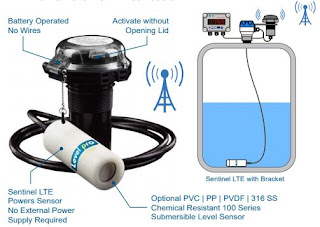Saturday, November 30, 2019
Sunday, November 24, 2019
2. Controlling liquid level: To monitor the minimum and maximum level of liquids, continuous checking temperature, and pressure, the telemetry tank level is of great help and support.
3. Detecting leakage: in the liquid industries, there happens damages and leakages are one of them. Sensors also help to detect leakages and locate the area.
Sunday, November 17, 2019
Continuous tank level transmitters are versatile in observing liquid level needs. They can monitor water, diesel, lube oils and fuels, as well as various chemical and petrochemical liquids in different industries. Tank level sensors deliver reliable daily measurements that are both scheduled and event-driven. Remote monitoring tank level sensors are exceptionally flexible, eliminating the hassle of network and internet service.
 Features
of Tank Level Sensor
Features
of Tank Level Sensor
Tank level sensors, telemetry tank level sensor, includes
amazing features like monitoring and measuring the liquid, substance,
chemicals, fuels and so in. Details
about the tank level sensor are given below:
1. Monitoring
liquid level: tank level sensor, a telemetry tank level sensor, checks the
levels of fluids, liquids, fuel, chemicals within the tank and shows signals
for crossing the maximum or minimum level which might be unbelievable without
the help of sensors. Because the telemetry tank level sensor reaches every
single point of the tank.
Conclusion
Modern tank level sensors have brought Renaissance in the
industry sectors. It gives plenty of new facilities with unique technological
advantages that deliver subtle measurements. Instead of thinking about the huge
costs for sensors, one might think about the broaden benefit of it as it can be
considered as an investment for the longer-term.
Contact us for more details:
Icon Process Controls Ltd (USA)
1-855-TRY-ICON (879-4266)
sales@iconprocon.com
Icon Process Controls Ltd (Canada)
P. 905.469.9283
F. 905.469.9159
sales@iconprocon.com
x
Saturday, November 9, 2019
The twenty-first century is all about technology and
utilizing advanced technologies to enjoy more benefits than ever before. The
more you are used with techs, the less you waste your time in monitoring,
evaluating and measuring the discrepancies.
Talking about the invention of modern science, the level
sensor is one of those inventions that have led people to gather so many ideas
that was hardly possible to carry out work accurately. Here you will come to
know the importance of a submersible level sensor and how people can get over
the risks with the help of it.
Contribution of the
submersible level sensor
Coming to the contribution of the submersible sensor, in
industries, the importance is huge and nowadays industrialists feel the
necessity of using sensors for vast reasons. In brief, here are some examples:

1.
Continuous level measurement: the most
significant part within industries like water, chemicals, liquids, food, and
beverages is to measure the continuous level of depth. The submersible level
sensor is designed in such a way to measure the aggressive liquid media and
provide information to the extent. The incredible feature is it works on vapor,
foam, and turbulence and has excellent chemical resistance.
2.
Pressure measurement: it is one of those
significant stages where works need to be carried out with perfection and
accuracy. The submersible level sensor detects the accurate pressure as it
doesn't come in touch with air and is free from floating along with a rapid
response.
3.
Sewage treatment: for wastewater treatment,
inventory management, chemical dosing, and so on, steps in sewage treatment,
can be smoothly completed by using the submersible level sensor.
Conclusion
With the help of a submersible level sensor, people working
in the production houses or industries can maintain regular monitoring and
recording of the appropriate measurements for temperature, pressure, consistency
and other important factors to ensure a risk-free environment and lower
wastage. In total, for safety and betterment, make the ultimate implementation of
the submersible level sensor.
You should learn before buying
Before buying a submersible level sensor, assess the specific requirements of your application. Consider the type of liquid being measured, as some sensors are better suited for corrosive or viscous fluids. Evaluate the depth of measurement needed and ensure the sensor can operate effectively at that range. Durability is key, so look for sensors with robust materials like stainless steel or PVC that can withstand long-term immersion. Check for compatibility with your existing systems, including output signals and power supply. Additionally, consider factors like ease of installation, maintenance, and the sensor’s accuracy and reliability to ensure it meets your operational needs.







